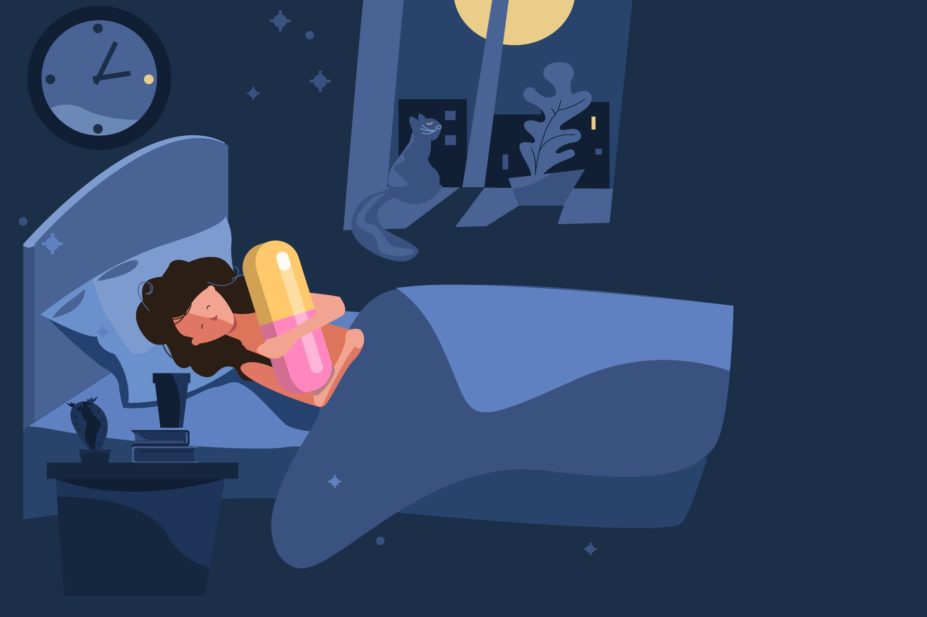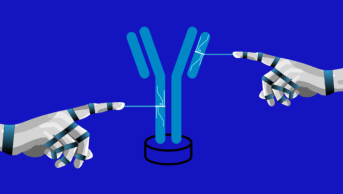
Mclean/Shutterstock.com
Daniel Hoyer, a pharmacologist from the University of Melbourne, recalls when, in 2006, Patrick Kennedy crashed his car into a security barricade near the capitol. Kennedy, a Democratic Party member of the US House of Representatives, insisted he was late for a vote. “It was three o’clock in the morning,” Hoyer says. “It turns out he was on zolpidem.”
Hoyer notes that zolpidem, a ‘Z-drug’, works by enhancing the effect of neurotrasmitter gamma-aminobutyric acid, just like benzodiazepines. These medicines are commonly given for insomnia. “Benzodiazepines and Z-drugs tend to affect your memory,” he explains. They also work as muscle relaxants, which in vulnerable groups, such as frail older people, can lead to falls. All of these side effects are exacerbated by the consumption of alcohol.
“If you have a benzodiazepine or Z-drug on board, you’re not completely functional,” he says.
Hoyer contrasts this to a new class of sleep medicines: dual orexin receptor antagonists (DORAs). “They don’t affect memory and they don’t have an effect on muscle. For [older] people — or whoever else needs to wake up in the middle of the night — they’re able to wake up and be completely functional.”
Our formulary for treating insomnia is somewhat restricted in the UK
Despite this, there have been problems for those trying to get DORAs to market. The first in its class to be approved, suvorexant (Belsomra; Merck) is now licensed in the United States, Japan and Australia, but Merck is yet to apply for EU approval. “I think there’s a general prejudice about sleeping medication,” says Hugh Selsick, consultant in sleep medicine and psychiatry, and lead clinician at the Insomnia Clinic at University College London Hospital.
“Our formulary for treating insomnia is somewhat restricted in this country, if you compare what we have here to what they’ve got in the United States,” he continues.
However, pharmaceutical companies in the United States are facing increased demands to prove the safety of their compounds. And this may be particularly true for indications that aren’t seen as being particularly important. “I don’t think that insomnia is viewed as a high priority medication,” says Thomas Roth, director of the sleep centre at Henry Ford Hospital in Michigan.
Mental health
Insomnia is a major global health problem. Although estimates vary, it is thought to affect approximately 20% of the population at any one time[1]
,[2]
. To receive a diagnosis of chronic insomnia (also known as insomnia disorder), a person should experience difficulty falling asleep, staying asleep, and/or have a propensity to wake up too early in the morning. At least one of these symptoms should be present for three nights per week for a minimum of three months, and the problem must be accompanied by difficulties with daytime functioning. Acute insomnia, by contrast, can last for days or weeks.
Those problems with daytime functioning mean that insomnia “has the same impact on quality of life as major depressive disorder”, says Selsick. This problem comes at a cost: the mean total healthcare expenditure for those with insomnia is 60% higher than for those without[3]
. People with insomnia tend to be less productive at work, are more likely to have an accident and are more likely to take time off sick
[3].
More concerningly still are the links between insomnia and mental health issues. “There’s no question that it is a huge risk factor for depression — it predisposes to anxiety disorders, to substance misuse,” he adds.
Incidence of insomnia
Selsick observes that it is difficult to know whether the incidence of insomnia is increasing, owing to variability in study methodologies. But “what we can definitely say is that there are certainly more people complaining about it than there used to be”, he says, citing the fact that his clinic is about to almost double its number of staff to try to keep up with demand.
He is glad that people are realising that “it’s not something that I just have to grin and bear for the rest of my life”. But, he believes, GPs are underprepared and underequipped to deal with insomnia.
“I have sympathy … because most doctors have practically no training on sleep medicine at all,” Selsick says.
Mostly, GPs tend to prescribe a short course of sleeping pills, which may work “if someone’s got acute insomnia — if they’ve got a big exam next week,” he explains. However, if they have chronic insomnia, then “they have two weeks of relief and when the pill stops they go back to sleeping badly”.
DORAs don’t shut the central nervous system down, they shut the wake system down
Sleeping pills are not a cure. However, DORAs work on a different sleep pathway to other sleeping pills and, as such, hold promise for patients with particular kinds of insomnia, vulnerabilities or issues with benzodiazepines, such as addiction. “They don’t shut the central nervous system down —they shut the wake system down,” Roth explains.
He sees insomnia as a disorder of hyperarousal. “People think that stress causes insomnia, but, in fact, it’s a differential reaction to stress,” Roth says. Any trigger for sleeplessness — such as caffeine, jet lag or a strange sleeping environment — will affect someone with insomnia more than the general population. Orexin is a neuropeptide that is necessary to maintain a state of being awake — people without orexin experience narcolepsy. The hope, therefore, is that taking DORAs will help generate a more ‘natural’ sleep state.
There are two types of orexin receptors — orexin 1 and orexin 2. Only orexin 2 seems to be directly involved in the sleep pathway, but DORAs block both receptors. “There is an interaction between the two receptors, because if you combine orexin 1 and orexin 2 you clearly see some kind of potentiation,” Hoyer says. So far, there do not seem to be any major side effects caused by blocking orexin’s other functions, such as in control of appetite, according to Roth.
Clinical trials
Despite their promise, pharmaceutical companies are struggling to get DORAs to market — at least in the form that they would like. Merck, which has led the way with suvorexant, studied doses of between 15mg and 40mg of the drug in its phase III clinical trial and found that all doses were superior to placebo and generally well tolerated[4]
. However, when it took its results to the US Food and Drug Administration (FDA) and proposed selling suvorexant in doses of 15mg and higher, it was told that 10mg should be the starting dose for most patients. It is hard to know what exactly spooked the FDA, but one suggestion is that it was data that showed that suvorexant use at 20mg and 40mg could impair driving, which — given high-profile cases such as Kennedy’s — was a big red flag[5]
. Other theories include suvorexant’s relatively long half-life of approximately 12 hours, which means that it could accumulate in the body with long-term use.
Whatever the reason, the FDA said that it would consider approving suvorexant, but only if Merck provided data for a starting dose of 10mg, or even 5mg, explains Hoyer, “which is remarkable because they didn’t have a 5mg pill,” he says. Although Merck’s phase II data showed that a 10mg dose helped with objective measures of sleep, patients did not report any subjective benefit[6]
. The company was forced into accepting a starting dose that patients may not feel is helping them.
Merck is not the only company with a DORA in the pipeline. Lemborexant, which is in development by Eisai, “has been filed for market approval for treatment of insomnia disorder with the [FDA] and with the Pharmaceuticals and Medical Devices Agency in Japan,” a spokesperson for Eisai says. Daridorexant (formerly called nemorexant) is being developed by Idorsia and is currently in phase III trials. “Potentially, we could be filing for approval by the end of 2020,” a spokesperson for Idorsia says. Janssen and Minerva are co-developing an orexin-2-receptor-specific antagonist, seltorexant (see Table).
| Drug manufacturer | Drug name | Stage of development |
|---|---|---|
| Merck | Suvorexant | Licensed in the United States, Japan and Australia |
| Eisai | Lemborexant | In review in the United States and Japan |
| Idorsia | Daridorexant (formally nemorexant) | In phase III trials |
| Janssen and Minerva | Seltorexant | Completed phase II trials |
| GSK | SB-649868 | Discontinued |
| Merck | Filorexant | Discontinued |
| Actelion and GSK | Almorexant | Discontinued |
Some contenders have fallen by the wayside. Almorexant, a DORA that was in development by Actelion and GSK, has been discontinued. “Companies never tell you why they pull a compound,” Hoyer says. However, after looking at the product, he suggested that “it probably had some liver problems”. Another compound that was being developed by Merck — filorexant — was discontinued after phase II findings suggested the medicine “did not warrant further investigation”, a spokesperson for the company says.
Daridorexant is thought to have a half-life of between six and eight hours, which Idorsia hopes will reduce or eliminate any potential risk of next-day side effects. And seltorexant seems to be particularly promising in people with co-morbid depression and insomnia.
However, Roth cautions against believing any claims that one of these agents is particularly better than another, since there have been no comparative trials. Furthermore, most trials compare these compounds with placebo, so there are scant data on how they square up against existing insomnia medications. This is changing: for example, a 2019 study of a group of 30 men suggests that people taking suvorexant are essentially able to perform normally on being woken, compared with those on the benzodiazepine brotizolam[7]
.
Competition and other options
What is clear is that the FDA is worried about some of the older classes of insomnia medicines. In April 2019, it introduced a mandatory warning on boxes of Z-drugs about risk of serious injury owing to sleep behaviours, including sleepwalking and sleep driving.
Despite their somewhat bad reputation, Roth believes that benzodiazepines and Z-drugs are still of benefit. He says they are particularly useful for patients whose main difficulty is in falling asleep — something that DORAs are less effective at. Although they do have side effects, such as amnesia, the regulatory bodies were aware of these before granting approval.
DORAs are also competing against other classes of sleep medicines, of which the most popular are antihistamines and melatonin. Selsick says that antihistamines have relatively long half-lives, which means that daytime sedation and hangover “is a big problem”. And, he cautions, over-the-counter antihistamine sleep medicines, such as Nytol and Sleepeaze, come with anticholinergic side effects that can be dangerous. Melatonin, in contrast, seems to be safe and can be particularly useful for people with body clock disorders, such as jet lag; however, “when used for insomnia it’s a real ‘Marmite’ drug”, Selsick adds.
The National Institute for Health and Care Excellence’s clinical knowledge summary for long-term insomnia recommends cognitive and behavioural interventions, including cognitive behavioural therapy (CBT). This is something Selsick focuses on in his clinic because, he says, “it’s a cure rather than a treatment”. He adds that the practical techniques are useful for everyone living with insomnia, even those who do eventually need medicines, since they “make the medication more effective and make it much less likely that [patients] will develop tolerance”.
Although Selsick is an advocate for CBT, he wishes that he had more options when it comes to sleep medicines, in terms of what he can offer patients.
It is still possible that Selsick will be able to prescribe suvorexant. Merck stresses it has not given up on the European market, saying “we continue to evaluate our options”. Idorsia is hoping to file daridorexant in Europe and says that what may hold it back is not a concern that the medicine will not be approved, but rather “the prospects of getting a fair reimbursement rate”.
One area that DORAs could potentially show their advantage is in helping patients with neurological disorders, such as Alzheimer’s disease. “I wouldn’t give a benzodiazepine or Z-drug to a patient who is [living with] Alzheimer’s disease,” Hoyer says, citing the risk of exacerbating memory issues or causing falls. This is a line that Merck is actively pursuing.
For Roth, the solution to pushing insomnia up the agenda lies in how we evaluate the effectiveness of a medicine. He thinks the focus should not be so much on what it does to patients’ sleep, but how it affects their daytime impairment and the risks of mental health issues. “If one of these medications prevented incident depression, that would make it a very important drug,” he muses.
Hoyer believes that DORAs remain the most promising agents on the horizon for insomnia. “Everything we know from physiology and pathophysiology tells me that this is the way to go.”
References
[1] Roth T, Coulouvrat C & Hajak G.Biol Psychiatry. 2011;69(6):592–600. doi: 10.1016/j.biopsych.2010.10.023
[2] Morin CM, LeBlanc M & Bélanger L. Can J Psychiatry 2011;56(9):540–548. doi: 10.1177/070674371105600905
[3] Roth T.J Clin Sleep Med 2007;3(Suppl 5):S7–S10. Available at: https://www.ncbi.nlm.nih.gov/pmc/articles/PMC1978319/ (accessed December 2019)
[4] Herring WJ, Connor KM, Ivgy-May N et al. Biol Psych 2016;79(2):136–148. doi: 10.1016/j.biopsych.2014.10.003
[5] Vermeeren A, Sun H, Vuurman EFPM et al. Sleep 2015;38(11):1803–1813. doi: 10.5665/sleep.5168
[6] Herring WJ, Snyder E, Budd K et al. Neurology 2012;79(23):2265–2274. doi: 10.1212/WNL.0b013e31827688ee
[7] Soel J, Fujii Y, Park I et al. Proc Natl Acad Sci U S A 2019; In press.doi: 10.1073/pnas.1907354116

